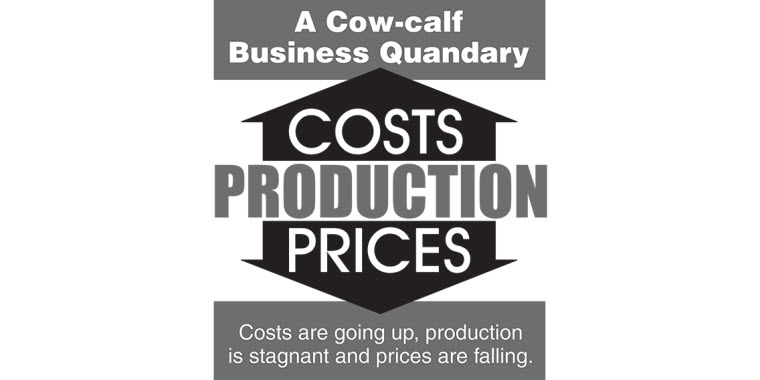by Kris Ringwall, Beef Specialist NDSU Extension Service
What happens when producers experience a 281 percent increase in the average price per hundredweight for calves in a 14-year period (2000 to 2014)?
Perhaps the tempting answer is “who cares!” There seems to be some truth to that answer, which is why the cow-calf business finds itself in a bit of a quandary. Costs are going up, production is stagnant and prices are falling. The response has changed and producers are saying “we care.”
The cow-calf business always is caught between a rock and hard spot when market discussions are presented. Producers generally focus on the market price of calves and are fairly prompt in noting a change in market direction.
The record prices of the past year are gone. Today’s backgrounders and feeder owners buy calves at a set price, projecting the expenses and income ability of calves on grass or in the feedlot.
As the market increased, feedlots managed cattle so carcass weights increased to help keep cattle in the yard and offset the price of incoming cattle. Ultimately, feedlots will revisit costs and adjust the price of incoming cattle to manage increased costs.
The willingness of the consumer to buy beef is part of the equation as well. Producers recognize the need for the inputs and projections, and know costs must be subtracted from income to calculate break-even points and, we hope, some profit. At the end of the day, did the operation provide a return on the investment?
Where are these thoughts coming from? My usual source for some answers is the North Dakota Farm and Ranch Business Management Education Program database (http://www.ndfarmmanagement.com) and associated search tools in FINBIN (http://www.finbin.umn.edu/) from the Center for Farm Financial Management, University of Minnesota.
A review of North Dakota numbers from FINBIN for 2000 compared with 2014 certainly shows the upward spiraling change during the 14-year period.
Let’s walk down the direct expense side of the numbers. FINBIN reports increases in expenses: feed supplements (protein, vitamins and minerals) up 294 percent, corn silage up 274 percent, alfalfa hay up 140 percent, grass hay up 165 percent, pasture up 200 percent and other feedstuffs up 154 percent. The total feed cost per cow is up 183 percent.
Veterinary costs are up 168 percent, supplies up 223 percent, fuel and oil up 311 percent, repairs up 231 percent and custom hire up 474 percent. Leases involved in livestock are up 103 percent. Marketing expenses are up 288 percent. Interest paid on operating is up 149 percent.
Total direct expenses have increased 191 percent since 2000. Overhead expenses also have increased 186 percent, and the cost of replacements have increased 225 percent.
So, costs are going up, production is stagnant and prices are falling. What can a producer do?
That is a difficult question because inflationary costs are going to happen. Service-orientated expenses also are inflationary. The service provider needs to have a salary increase to sustain the service. The same inflationary costs impact every business, and these costs are not unique to the cow-calf business.
The utilization of commodities offers some flexibility in moderating costs. However, hay costs are at the lower end of the percent price increase, indicative of commodity pricing. Calculating the cost per unit of energy and protein for all feed inputs is necessary to keep commodity prices as low as possible, although even the best input calculations spiral upward as feed wastage mounts up.
A good thought, but scary, as one drives down the feed lane spreading hay, is this: “Just how much of this hay are those cows actually eating?” Efficient feeding methods are critical to lower ever-increasing costs. Remember, any value-added commodity purchased reflects the cost of someone else’s labor.
In short, these hidden labor charges inflate the cost of production. But once again, service is a component of value added. If producers can’t do something themselves, they pay current labor rates to have someone else do the task.
To be honest, many businesses will look internally to increase production efficiency to offset inflationary costs. For the beef industry, as production has leveled, these added costs are very problematic. Producers cannot increase cost without any increase in output.
The increase in output is not occurring, so we need to ask, “Can the beef industry do as others do and increase production efficiency?” Perhaps, as difficult as it may be, peeking across the fence at the other competitive meats and asking how they manage efficiency would help. But cows are not chickens or pigs.
May you find all your ear tags.
For more information, contact https://www.ag.ndsu.edu/news or North Dakota State University Extension Service, NDSU Dept. 7000, 315 Morrill Hall, P.O. Box 6050, Fargo, ND 58108-6050.
Source: NDSU Extension


